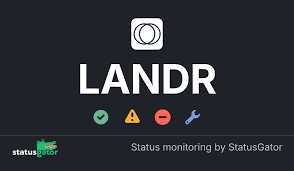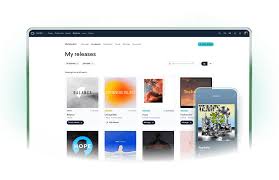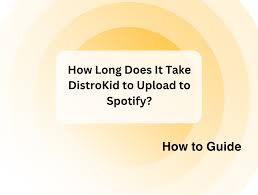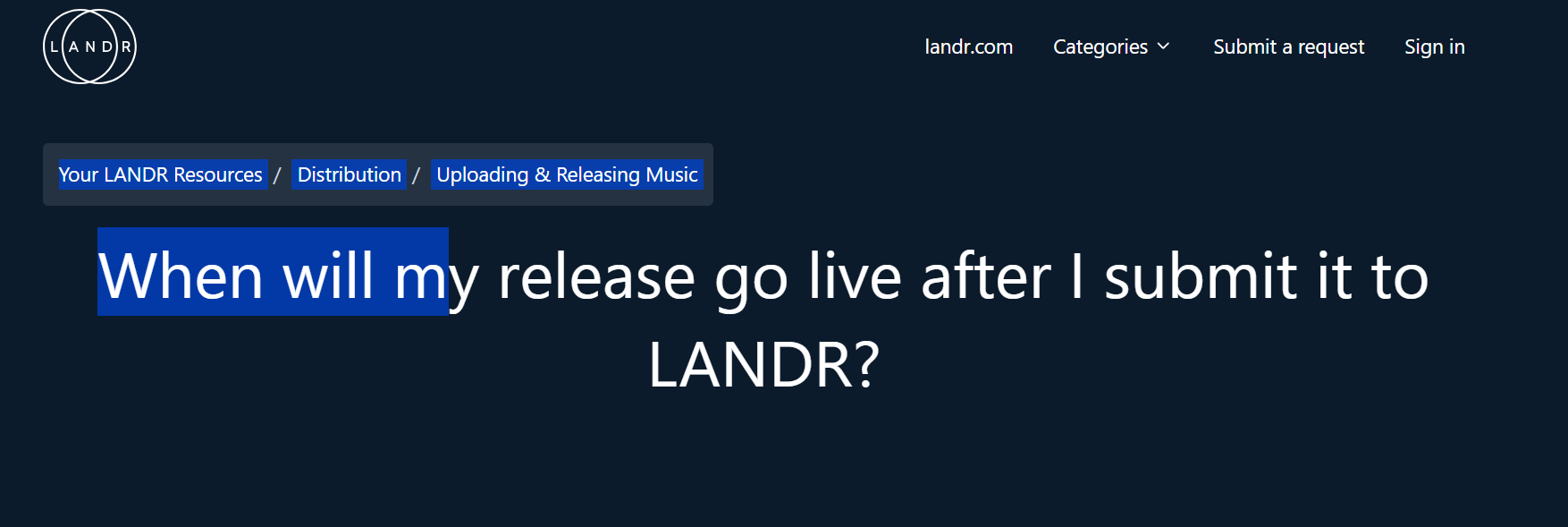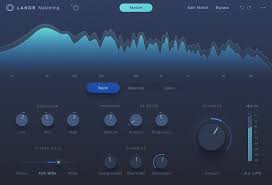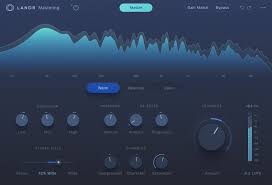As an independent artist navigating a fast-moving digital music world, choosing the right music distribution platform is one of the most important steps in building your career. While DistroKid and TuneCore often dominate the conversation, Symphonic and LANDR are two professional-grade platforms that offer powerful tools for serious artists.
So when it comes to Symphonic vs LANDR, how do they really compare?
In this in-depth review, we’ll explore everything from royalty splits to pricing, mastering tools, and marketing support. Whether you're an emerging artist or an established producer, this guide will help you make the smartest choice for your music distribution needs.

What Is Symphonic Distribution?
Symphonic Distribution is a selective music distribution and artist services company founded in 2006 in Tampa, Florida. Unlike open-door platforms, Symphonic requires artists and labels to apply for access—a gatekeeping process that helps maintain quality and ensures curated support.
Symphonic is more than just a distribution hub; it offers a full suite of services tailored to music professionals. These include royalty collection, publishing administration, sync licensing, YouTube monetization, and even physical distribution. It’s designed for creators who want a long-term business partner—not just a place to upload tracks.
Symphonic Core Features:
Distribution to 200+ DSPs, including Spotify, Apple Music, Tidal, Beatport, and Amazon
85% royalty retention (Symphonic takes 15%)
Sync licensing and TV/film placement opportunities
Optional marketing, PR, playlist pitching, and influencer outreach
YouTube Content ID & Vevo Channel creation
Physical distribution (vinyl, CDs) for selected artists
Hands-on support with account managers
What Is LANDR?
LANDR originally launched as an AI-powered mastering platform but has since expanded into a full creative suite. Today, LANDR provides artists with distribution, mastering, sample packs, collaboration tools, and plugin rentals—all under one roof.
Where Symphonic leans into professional music business services, LANDR leans into accessibility and creativity. Anyone can sign up and start releasing music within minutes, making it an attractive choice for beginners, producers, and bedroom artists.
LANDR Core Features:
Distribution to 150+ streaming platforms
Artists keep 100% of their royalties (on paid plans)
AI-powered mastering engine
VST plugin subscriptions and sound libraries
Music collaboration and file sharing
Publishing administration add-on
Custom artist pages with smart links
Symphonic vs LANDR: Key Differences at a Glance
| Feature | Symphonic | LANDR |
|---|---|---|
| Access | Application-only | Open to all artists |
| Royalty Split | 85% artist / 15% Symphonic | 100% artist (on paid plans) |
| Pricing | No upfront fee; revenue share | Starts at $20/year for distribution only |
| Distribution Reach | 200+ DSPs + physical distro | 150+ DSPs, digital only |
| Mastering | Not included | AI mastering included |
| Marketing & Sync | Available via account team | Limited marketing; publishing add-on |
| Best For | Labels and growth-stage artists | Indie producers, solo creators, beat makers |
| Add-On Services | Sync, publishing, physical sales, influencer PR | Samples, VSTs, mastering, publishing admin |
Pricing Breakdown: Subscription vs Commission
The biggest contrast between Symphonic vs LANDR lies in how they price their services.
Symphonic doesn’t charge you upfront. Instead, they take a 15% cut of your royalties. There are optional service costs for extras like playlist pitching or vinyl pressing. While you pay less at the start, the long-term cost grows with your success.
LANDR uses a flat-rate subscription model. Their distribution-only plan starts at $20/year, and their All Access plan (which includes mastering and samples) costs $149/year. With LANDR, you keep 100% of your royalties, making it ideal if you’re confident in your earnings.
Distribution Network and Platform Integrations
In the Symphonic vs LANDR battle for reach, Symphonic wins on sheer scope. Symphonic supports 200+ global DSPs, including niche platforms like Beatport, Traxsource, and Boomplay, making it especially popular among electronic, Latin, and world music artists.
LANDR distributes to all major platforms—Spotify, Apple Music, YouTube Music, TikTok, Amazon, Deezer—but lacks depth in niche genres and does not support physical releases.
Symphonic also offers territorial exclusivity options, catalog control, and manual metadata management, which are must-haves for growing indie labels.
Artist Support and Extras
Here’s where things really start to diverge:
Symphonic assigns real account managers to eligible artists. That means you get email support, strategic guidance, and custom help with playlist pitching, press kits, and even live event strategy.
LANDR, on the other hand, is designed for self-service. Most of its value lies in its tech: AI mastering, plugin rentals, and creative collaboration. If you like doing everything on your own, LANDR might feel more empowering—but also more isolating if you hit roadblocks.
Tools for Creators Beyond Distribution
What makes LANDR unique is how it bundles music creation and distribution tools:
AI mastering helps polish your tracks automatically.
Plugin subscriptions let you rent premium VSTs for less.
LANDR Samples gives you royalty-free packs to build beats and tracks.
Collaboration tools let producers share and comment on projects.
Symphonic doesn’t include those creator tools—but that’s because it’s not trying to be a studio. It’s trying to be a music business engine for independent labels and serious artists.
Which Platform Should You Choose?
Let’s simplify the Symphonic vs LANDR decision:
Go with Symphonic if you:
Are part of a label, collective, or serious indie project
Want sync licensing, playlist pitching, and advanced reporting
Are interested in physical distribution or vinyl pressing
Prefer having a real human team backing your release strategy
Go with LANDR if you:
Are a solo artist or home producer
Want everything from mastering to distribution in one place
Prefer low-cost subscriptions over revenue sharing
Like experimenting with sounds, plugins, and samples
Real-World Reviews: What Artists Are Saying
Symphonic is praised for its white-glove approach and deep distribution infrastructure. Artists like R.A. the Rugged Man and indie labels like Gravitas Recordings have publicly applauded its hands-on support and transparency.
LANDR gets excellent feedback from electronic producers and bedroom musicians for its fast mastering and easy-to-navigate dashboard. However, some users report limited customer support and basic distribution analytics.
Conclusion: Symphonic vs LANDR — A Strategic Choice
Ultimately, choosing between Symphonic vs LANDR depends on whether you're looking for a creative toolkit or a business growth engine.
LANDR is perfect for early-stage creators who want everything in one interface.
Symphonic is better suited for growth-phase artists and labels ready to invest in strategic services and professional reach.
If you're ready to scale and care about sync, monetization, and expert advice, Symphonic wins. If you’re just trying to release high-quality tracks quickly and affordably, LANDR is a strong start.
FAQs: Symphonic vs LANDR
Is Symphonic Distribution better than LANDR?
It depends. Symphonic offers more professional services and a broader distribution network. LANDR offers built-in mastering and creative tools at a lower entry cost.
Do I need approval to join Symphonic?
Yes. Symphonic has a selective approval process to maintain quality. LANDR does not require approval.
Does LANDR really let me keep 100% of royalties?
Yes, but only if you're on a paid distribution plan. The free plan takes a 15% cut of your royalties.
Can I use LANDR just for mastering?
Absolutely. LANDR's AI mastering tool can be used without subscribing to the distribution service.
Learn more about AI MUSIC

